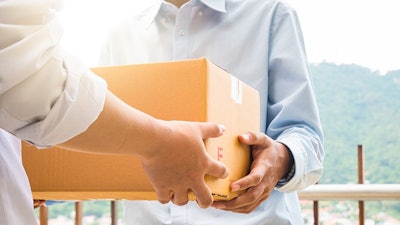
There are many factors to consider when launching a delivery-only cannabis business or when adding delivery services to an existing dispensary, from complying with additional regulations to understanding the demographics of potential new customers.
California-based Goddess Delivers faced many of these challenges when it launched a delivery-only cannabis company in 2011.
COO Zach Pitts founded the business with his partner, Charlie Green, after Green discovered that many of the early cannabis shops in the Los Angeles area seemed to be geared toward young men, excluding other clientele.
“She wanted much more of a focus on the holistic medicine side of things, and so that’s why we named the company the way that we did, and that’s been our guiding philosophy of making people comfortable with it, introducing people to it [and] introducing the health benefits … surrounding cannabis,” Pitts tells Cannabis Dispensary.
At the time, California did not have comprehensive medical marijuana regulations, he says, and cities were implementing their own rules, which varied widely from one municipality to another. Goddess Delivers had to adopt a flexible business plan and embrace change as the state has worked to roll out statewide rules and licensing.
The company does not operate a storefront—patients can place orders online or over the phone. This type of model allows for lower startup costs and a smaller and more flexible business, Pitts says.
Goddess Delivers is prepared to transition this model and expand into the California’s adult-use market, once it receives its license, he adds.
Here, Pitts shares his top tips for operating a successful cannabis delivery service, based on experience in California’s burgeoning market.
1. Know the regulations.
While states like California and Oregon allow cannabis delivery, others outright ban it.
“A lot of times when the regulators are talking to the police, delivery brings up this idea of the black market and of uncertainty in the ability to create safety and prevent diversion,” Pitts says. “In fact, it’s really just a different way that people order products, and it can be just as safe as a storefront, if not [safer], because you don’t have customers on-site with a delivery-only service. There’s no nuisance to it, no signage, no people loitering outside.”
In a delivery-only operation, cannabis and cash is stored and processed in a secure place that is not accessible to customers, Pitts says, but state and local regulations often require a baseline of security similar to a retail storefront. This includes alarm systems, locks that meet certain quality standards and a saferoom to store cash and/or products. Video surveillance is another common requirement, Pitts adds, and there are often quality requirements for the video and how long the video must be retained on-site.
“Then, there are requirements on how things are delivered,” he says. “Usually they universally require that there’s an address, so we’re not just delivering to the gas station on the corner, or something like that.”
Employees must also verify that the delivery is made to someone of legal age in adult-use markets, or someone with a valid medical marijuana card in medical markets, Pitts says.
The drivers must be licensed and insured, he adds, and in California, GPS devices are required in the vehicles to allow for remote tracking.
And as the regulatory and licensing process continues to roll out in California, it is important to take a conservative stance and anticipate what the rules might be, Pitts says.
2. Understand your market.
“I think what’s important with delivery services … [is] that it’s very much a different market than storefronts,” Pitts says. “The people who use delivery services are just a different demographic.”
Clientele tend to be older, he says, and they want convenience.
“They might have medical conditions that reduce their mobility, [or] they just might like the slightly more private interaction that you get from delivery versus going to a storefront,” Pitts says. “It’s important to keep that in mind.”
3. Build trust with your customers.
Establishing relationships based on trust with your customers is also critical to a successful delivery service, Pitts adds.
“You really want to think about what’s going to be most safe for your drivers, for your employees … [and] for your patients,” he says. “You want to make sure that the product that you’re providing is high-quality because they can’t necessarily ascertain that from the website or just by calling you.”
By consistently providing high-quality products, businesses can build customer loyalty, Pitts says.
“Even more than storefronts, [with] delivery, you have to have a relationship with your customers, and they have to trust you,” he says. “There’s just more trust in your ability to provide them with a product that is enjoyable and satisfactory than other places because in other types of retail situations, the choice is a little bit more on the customer, whereas in this, it’s much more in our ability to satisfy the customer.”
4. Educate your customers.
Since cannabis is still a new industry, many customers are unfamiliar with it, and they may find some of the regulations surrounding the industry—and delivery services—frustrating.
“It’s interesting because it’s a new industry, so you have to introduce the consumer to the very idea of the industry,” Pitts says. “You have to introduce the consumer to the very complicated regulatory framework because there are going to be frustrations that the consumers might feel over ordering that we are forced … to do to follow the regulations, [and] that aren’t ideal for operations in business in general but are important to ensuring a certain level of safety and security, and paying certain taxes.”
Businesses should be willing to teach their customers about what cannabis is, its many forms, what it can do and how to consume it safely to have a positive medical outcome or an enjoyable experience, Pitts says.
5. Get creative with advertising.
Advertising is tricky for all cannabis businesses, and delivery services are not immune, Pitts says. A company like Goddess Delivers, which advertises its products for sale online, may face additional challenges, he adds.
“You have the difficulty of advertising a product that is federally a controlled substance and illegal for all uses,” he says. “So, traditional methods that you might [use to] advertise a product online are not available to you. You have to be a little bit more inventive in some ways. You have to work more the word of mouth advertising.”
Companies should understand the advertising regulations in their local communities and test different methods to find what works best, Pitts says.
6. See what works and build your business model accordingly.
Trial and error can help delivery services better understand their markets and adjust their business models accordingly, Pitts says. And companies shouldn’t try to reinvent the wheel.
For example, not many point-of-sale systems are available for the delivery side of the industry yet, Pitts says, but by looking at the ways in which other industries handle order fulfillment and delivery, the cannabis industry can find solutions.
“In some ways, you can look at best practices for any sort of fulfillment operation or shipping operation,” Pitts says. “There are other businesses that have done the things that we’re trying to do, and just looking at what they’re doing and why they do it and [integrating] those practices into your own [can be beneficial].”
Another example is determining the range of a company’s delivery area, he says. “It’s different for everyone. Some people do large regions. Some people do smaller communities. I think that’s another [case of] seeing what works for you [and] seeing what’s profitable and not for you.”
When considering a delivery service, businesses should assess how receptive the surrounding community is to delivery in the first place, how much the area is currently served and the cost for a driver to travel a certain amount of distance, Pitts says.
“In a dense urban environment, you might have a high concentration of customers, and the traffic might be bad enough that it’s difficult for you to go very far, but you’re also facing a lot more competition from other delivery services,” he says. “Whereas in a suburb, … there’s certainly less density, but also less competition.”
And while Goddess Delivers purchases product from a third-party, a vertically integrated model may work for other delivery services, Pitts says. “I don’t think there’s any downside or benefit to it, it’s just, can you handle the logistics of doing that, as well? We used to cultivate even while we had the delivery service running, but it just became too much for us to make sure the quality was high for us on our cultivation as well as making sure the delivery service was prosperous, so we let go of that cultivation. But other people might be able to manage those multiple businesses.”
7. Get involved with trade associations.
Seeking out trade associations is one of the most important aspects of running a delivery service, or any cannabis business, for that matter, Pitts says. Goddess Delivers is a member of the L.A. Delivery Alliance, and it has greatly benefited the company, he says.
“It’s really allowed us to communicate how we operate and what we need from regulators, and really understand where they’re coming from with the regulations and trying to help them achieve their goals,” Pitts says. “That communication, that interaction, is very important.”
Top Image: © boophuket | Adobe Stock










111.png?auto=format%2Ccompress&fit=crop&h=141&q=70&w=250)















